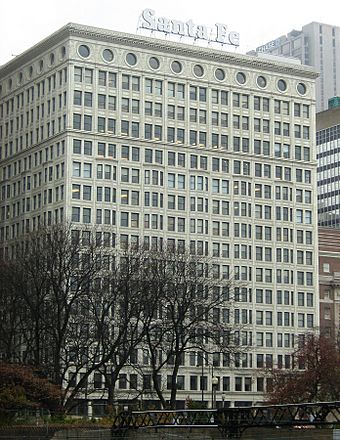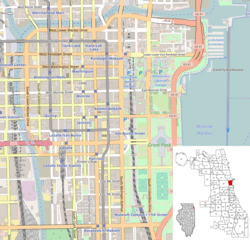Railway Exchange Building (Chicago) facts for kids
Quick facts for kids |
|
|
Railway Exchange Building
|
|

The Railway Exchange Building, prior to the 2012 removal of the "Santa Fe" sign
|
|
| Location | 224 South Michigan Avenue, Chicago, Illinois, USA |
|---|---|
| Built | 1903–1904 |
| Architect | D. H. Burnham & Company F. P. Dinkelberg |
| Architectural style | Chicago |
| NRHP reference No. | 82002530 |
| Added to NRHP | June 3, 1982 |
The Railway Exchange Building, also known as the Santa Fe Building, is a tall office building in Chicago, Illinois. It has 17 stories and is located in the Loop area, which is a busy part of the city. The building was designed by Frederick P. Dinkelberg from the company D. H. Burnham & Company. It was built in the "Chicago style" of architecture.
You can easily spot the building because of a big "Motorola" sign on its roof. This sign can be seen from Grant Park and even from Lake Michigan. The building also has cool round windows, like portholes, near the top. Inside, there's a central open space called a lightwell, which got a glass roof (a skylight) in the 1980s.
Contents
Building Design and History
The main entrance to the Railway Exchange Building is on Jackson Boulevard. When it was built in 1904, Jackson Boulevard was a more important street than Michigan Avenue. The architect, Daniel Burnham, who also owned a lot of the building, wanted a very grand entrance. His company, D. H. Burnham & Company, had offices on the 14th floor. His family owned parts of the building until 1952.
This building shows off the "Chicago School of Architecture" style. It also has fancy details from the "Beaux-Arts" style. Inside, there's a two-story court with a grand staircase. This court leads to shops and a balcony on the second floor. The outside of the building and the inner court are covered in shiny white terracotta. The lightwell inside is lined with white brick.
The building uses classic designs for its decorations. You can see ornamental dentils (small block shapes), balusters (small pillars), and fancy column capitals (the tops of columns). The entire building has a strong steel frame inside.
In 2012, the original "Santa Fe" sign on the roof was taken down. A new, lighted "Motorola" sign replaced it because Motorola Solutions moved into the building. The old Santa Fe letters were given to the Illinois Railway Museum. After being fixed up, the sign went on display at the museum in 2016.
A very important part of the building's history is that Daniel Burnham and his team created the famous 1909 Plan of Chicago here. They worked on this big city plan in a special room on the roof's northeast corner.
Who Used the Building?
The Railway Exchange Building was first built for the Santa Fe railway. It was a place where different railway companies could do business. As mentioned, Burnham & Company, the architects, also had their offices there.
In 2006, the University of Notre Dame bought the building. Their business school, the Mendoza College of Business, started holding classes there in 2008.
From 2009 to 2018, visitors could see a huge model of downtown Chicago in the building's main hall. This model was created by the Chicago Architecture Foundation. The foundation later moved to a new location at 111 East Wacker Drive in 2018. They also changed their name to the Chicago Architecture Center (CAC). The CAC still updates its bigger city model to show new buildings in downtown Chicago.
In 2011, a company called Anacostia Rail Holdings moved its main office into the Railway Exchange Building.
Where It Stands in Chicago's Skyline
The Railway Exchange Building is part of Chicago's famous skyline. You can see it in the image below, though it's not labeled. It stands in front of the Three First National Plaza building.

See also
 In Spanish: Railway Exchange Building (Chicago) para niños
In Spanish: Railway Exchange Building (Chicago) para niños


